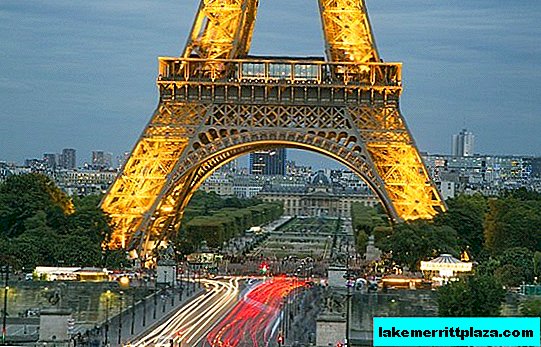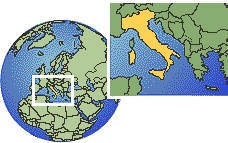What to see in Paris on your own in 1 day? We have tried to draw up an itinerary for you on an independent tour, covering all the most important sights. Moreover, if you wish, you can go through it both in 1 day, and breaking it into several parts. The most important thing to remember is that the center of Paris is very large. To do everything, it is advisable to get up early and prepare comfortable shoes.
From Trocadero Square to the Latin Quarter
Our route begins with Trocadero Square - it is from here that a stunning view of the main symbol of Paris to the Eiffel Tower opens. The easiest way to get to the square is by metro - the station of the same name is located at the intersection of lines 6 and 9.
The main decoration of the square is the majestic Chaillot Palace, which grew up on the site of the once Trocadero palace. Today, the Palace housed several museums at once (Museum of Man, Maritime Museum and Museum of Monumental Art of France), as well as a theater.

Stunning views of the Eiffel Tower from Piazza Trocadero
If you are not a fan of going to museums, immediately go down to the wonderful gardens at the foot of the square. They also bear the name Trocadero. Walking in this shady park among green trees, sculptures, numerous streams and fountains is a pleasure.
Be sure to pay attention to Warsaw Fountain - the largest in Paris. The fountain does not always work, it does not have a clear schedule. But if you still caught the right moment, this sight will surely impress you.
But let's not waste time - there is still a lot of interesting things ahead. Leaving for the Seine embankment, we’ll go to the opposite bank along the Jena bridge to go to the most recognizable symbol of Paris - Eiffel tower.

More than 6 million tourists climb the Eiffel Tower annually
The Eiffel Tower is considered the most visited attraction in the world. More than 6 million travelers climb it every year, and this is what you need to see in Paris in 1 day.
You can get upstairs by elevator or by combining the elevator and the stairs (it will be a little cheaper). Below is usually a huge line of people eager for a lift, and here it is quite possible to get stuck for several hours.
If you want to have time to cover all the most important things in Paris, and time is limited, then it is better to purchase tickets for the Eiffel Tower in advance - via the Internet. You can do this on this page.

Parisians love picnics on the Champ de Mars
Right behind the Eiffel Tower Champ de Mars, once served as a venue for parades, and now it is one of the most famous parks in the world, where the townspeople and tourists are very fond of picnicking.
In continuation of the walk, a journey by public transport awaits us. To the right of the tower is the Champ de Mars stop. There we take bus number 82 and go to the final stop in the direction of Luxembourg.
From Saint-Michel Boulevard to Cité Island
Coming at the Luxembourg stop, we will find ourselves on Saint-Michel Boulevard in the most “learned” area of the city - Latin quarter. The best educational institutions of Paris are concentrated here, and life in the surrounding streets is always seething and everywhere the reckless atmosphere of students reigns.
At Edmond Rostan Square, 150 meters from the Luxembourg stop, turn right onto Suflo Street, at the end of which Parisian Pantheon - A kind of analogue of a Roman elder brother.

Pantheon - the tomb of prominent French
Initially, the building was conceived as the church of St. Genevieve, but over time its purpose changed. Today the Pantheon is the tomb of prominent French. Here lie Voltaire, Russo, the spouses of Curie, Victor Hugo, Dumas, Emil Zola, mathematician Lagrange and other significant figures of French history, politics and science.
Having examined the Pantheon, we return to Saint-Michel Boulevard and move on - to one of the oldest universities in Europe, around which the Latin Quarter grew - Sorbonne.

Sorbonne - one of the oldest universities in Europe
Back in the 13th century, the university reached an unprecedented peak and enjoyed the highest reputation in all of Europe. But today the Sorbonne itself is gone. After the student strikes of 1968, the University broke up into 13 separate educational institutions, some of which continue to occupy the historical building of the Sorbonne.
From the Sorbonne only about 500 meters to the next iconic place in Paris - the island of Cité. To get to it, you can walk along the boulevard Saint-Michel and cross the bridge of the same name.
Cite Island
The island of Cité is exactly the place where in the 1st century BC BC e. the first settlement arose, around which modern Paris grew.
Immediately after the bridge we are met by the complex Palace of Justice, whose history is from the VI century. Over the past centuries, the palace has been rebuilt many times, but some elements have survived in their original form.
In particular, Conciergerie's Palace - used to be a royal residence, but in the XIV century. she was moved to the Louvre, and the building itself began to serve Themis.

Once the Conciergerie was the residence of the kings, today it is a museum
To this day, meetings are held in the Palace of Justice and judicial institutions operate. But the Conciergerie’s palace has been turned into a museum, and it can be visited without hindrance during business hours.
Another landmark building on Sita - Chapel Saint Chapelle. It was erected specifically to store valuable Christian relics acquired by Louis IX during the reign. One of them was a crown of thorns with the blood of Jesus Christ, which the king bought for fabulous money for those times.
The chapel itself is small, but it is one of the most beautiful examples of late Gothic. The main decoration of the Holy Chapel is stained glass windows with a height of 15 m. Each of them depicts a scene from the Old or New Testament, telling a biblical story from the beginning of time until the arrival of sacred relics stored in the chapel in Paris.
Only 150-200 meters from the chapel of Saint-Chapelle is the main attraction of the island of Cite - the legendary Notre Dame de Paris - one of the most recognizable temples in the world.

The construction of the Notre Dame de Paris Cathedral began in 1163 and lasted almost 200 years.
The construction of this grandiose cathedral began in 1163, and more than one generation of architects was replaced by its end - the process lasted almost 200 years. It is believed that once on the site of Notre Dame stood the first Christian basilica of Paris. In its lifetime, the cathedral has seen many events - the most important milestones of history took place within its walls.
If your legs are still able to overcome a steep staircase of 387 steps, you can climb to the observation deck in the southern tower of Notre Dame. It is open daily, and in the summer months until late in the evening. Tickets cost 10 euros. Entrance to the cathedral is free. But, since the place is incredibly popular, you have to defend it in a long line.
Right bank of the Seine: from Place de Ville to the Louvre
After visiting the Cathedral, our path lies on the right bank of the Seine. On the Arkol bridge we will go directly to the city hall building Hotel de Ville, which is located on this place since the XIV century. True, the current city hall is not so ancient; it was built in 1882.

Hotel de Ville is accessible via the Arcol Bridge
From here we head to Rivoli street - one of the longest in Paris. The next point of our self-guided tour is The louvre museum.
A visit to Paris is hard to imagine without visiting the most famous museum on the planet - the Louvre. This treasury of world art holds hundreds of thousands of masterpieces that have no price.
To get here spontaneously will be quite difficult, because the place is extremely popular with guests of Paris. As part of this walk, we recommend that you simply confine yourself to an external examination, and if you are in Paris for more than 1 day, then return separately to examine the exhibition, allocating at least half of a full day for this.

The Louvre Museum is the most famous museum on the planet.
Since there are long lines at the entrance to the box office, in which it is quite possible to lose a few hours, you will save a lot of time and nerves if you purchase a ticket in advance via the Internet. You can do this on this page.
Another great way to see the Louvre quickly is to sign up for one of the popular excursions in Russian:
- A popular budget group tour that already includes tickets
- A popular private tour with many positive traveler reviews
From the Louvre to the Arc de Triomphe
Directly behind the Louvre is the Tuileries Garden. It was defeated here under Catherine de Medici in 1564, but was later redone according to the plan of landscape architect Andre Lenotra.
Passing the park, we exit to the largest square in Paris - Place de la Concorde. There were times when executions were carried out here, and in the center stood a frightening guillotine. Now here is the ancient Luxor Obelisk, donated to France by the Egyptian ruler.

In the old days, there was a guillotine on Place de la Concorde and executions took place.
Just beyond the square begin Champs Elysees. Along the main street of Paris there are boutiques of the most prestigious brands and offices of large companies. The length of the Champs Elysees is about 2 km, but it's worth a walk.
Announces the end of the Champs Elysees Triumphal Arch - Another point that you must definitely see in Paris even in 1 day. The arch was built as a symbol of the victory of Napoleon’s troops near Austerlitz and is one of the most recognizable sights of Paris.

Arc de Triomphe - a symbol of the victory of Napoleon’s troops near Austerlitz
At the top of the Arch is an observation deck, from where it is possible to admire the center of Paris. It is better to buy a ticket here, as well as to other popular sights of the capital, in advance via the Internet as long queues form at the ticket offices.
Montmartre
From what is worth seeing on your own in Paris and about which we still have not mentioned - the most bohemian district of the city - Montmartre. The easiest way to get here from the Arc de Triomphe is by metro on line 2 to Pigalle Station.
Montmartre's most iconic street is Clichy Boulevard. It was here that at one time the greatest artists lived and worked: van Gogh, Degas, Picasso, etc. But there is another side to this street: once it was the Paris red light district, and this reputation has remained with it today.

From the observation deck of the Sacre Coeur opens a panorama of all of Paris
Looping through the streets and ladders, we make our way to the snow-white Sacre Coeur Basilica. It was erected just a little over a century ago in memory of the victims of the Franco-Prussian war. There is an observation deck on the bell tower of the church, which offers views not only of Montmartre, but also a panorama of the whole of Paris.
Walking around Montmartre, you can end a day filled with impressions in a nearby cabaret Moulin Rouge. Remember that the institution has a dress code, so comfortable clothes will have to be changed to something more formal.

Walking around Montmartre, you can look into the famous Moulin Rouge cabaret
However, a cabaret trip is not the only option to spend an atmospheric evening in Paris. You can go on a cruise along the Seine or visit the Paris Opera. Or you can return to Trocadero Square and watch the enchanting light show at the Eiffel Tower.
Self-guided tour of Paris
Of course, Paris is a city extremely rich in sights and one day is not enough for him. Ideally, allocate at least 4 or 5 days to the French capital, and even better - a full week.
Even in this rather large article, where we tried to outline the most basic points, I had to miss a huge number of the most important sights that are within walking distance, which turned out to be simply impossible to fit into the format of the material.
It is not surprising that many travelers overlook many places, even being literally around the corner from them.
That is why at the very end of 2017, together with a professional guide in Paris, we drew up an extremely detailed self-guided tour of the city for 1 day.
Moreover, this is not just one of the many guidebooks, but a ready-made step-by-step plan for the whole day, which will save you a lot of time and money for preparation and allow you to come to Paris as a real expert in the city to take the maximum from your visit.

The Champs Elysees has boutiques of the most prestigious brands
Here is what you will find inside the Route:
- Ready walking route for a self-guided tour for 1 day, covering 32 main sights of Paris
- A detailed online map of the route of Google Maps, as well as labels for Maps.me, so that you can easily transfer the map to your smartphone or tablet and use without internet
- PDF version of the route: you can simply print it and take it with you or read directly from the screen
- Little-known but interesting places that most tourists lose sight of
- 9 viewing platforms along the route so that you have the best photos
- The main details about the main attractions of the route, as well as their detailed mode of operation
- Where to eat colorful and what to try from food tips from local residents and a guide directly on the route, without riding around the city
- How to visit free and budget excursions in Paris to save hundreds of euros without losing experience
- Specially selected mobile application with free audio tours of Paris
By the way, the Route in Paris can be purchased both separately and complete with Amsterdam and Brussels located just a few hours away. See a detailed description of all routes on this page.
And finally - it’s necessary save this article on social networksso as not to lose. When planning your trip, it may come in handy to you more than once. To do this, use one of the buttons below.








